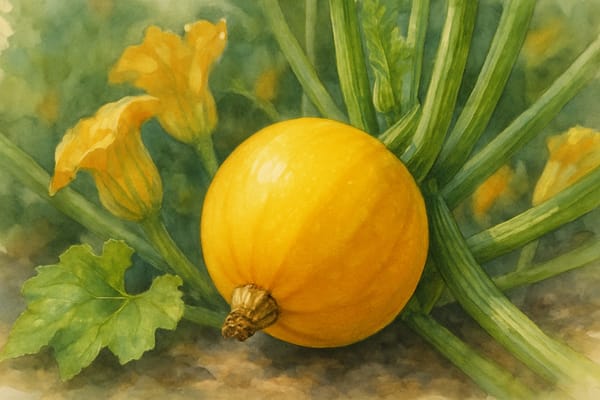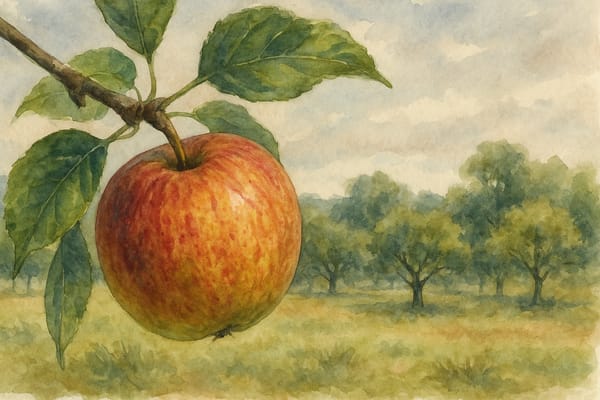A golden harvest in miniature form
Tucked into the corner of a sheltered garden, where the sun lingers on low stone walls and bees hum lazily among marigolds, you might spot something unexpected: small, golden orbs resting close to the soil, cradled by soft, serrated leaves. These are courgettes — but not the usual kind. This is ‘One Ball’ F1, a cheerful, compact variety whose bright yellow, rounded fruits seem made for summer kitchens and smaller garden plots alike.
Why We Love It
‘One Ball’ is a bush-type courgette, which means it doesn’t trail or sprawl across the beds like some of its cousins. Instead, it grows upright and tidy, making it a joy to grow in containers, raised beds, or smaller spaces — ideal for Cornish gardens where windbreaks, microclimates, and layout quirks often shape how we plant.
The fruits are round, smooth, and glossy — best picked when they’re no larger than a tennis ball. At this size, the texture is tender and the flavour sweet and mild. Roasted whole, stuffed with herbs and cheese, or sliced raw into a summer salad, they bring both charm and taste to the table.
Sowing from Seed: Indoors
To give your plants the best start, begin indoors in April or May — on a warm windowsill, in a greenhouse, or under cover in a bright utility room.
- Fill 7–9cm pots with peat-free, multipurpose compost.
- Sow one seed per pot, and here’s the gardener’s trick: lay it on its side, not flat. This helps prevent rot as it begins to swell and split.
- Push the seed down gently to 1.5–2cm deep, then cover lightly.
- Water gently with tepid water to moisten the compost.
Place the pots in a warm place (18–21°C), and within 7–10 days, you’ll see those strong, rounded seed leaves begin to unfurl. As soon as they do, move the pots somewhere bright and well-ventilated — avoiding leggy, pale seedlings caused by low light.
When two or three true leaves have emerged, pot them on into larger 2L pots. This step helps develop strong roots and sturdy stems. Then, harden off: place them outside during the day and bring them in at night for a week or so. By late May, they’ll be ready for life in the garden.
Direct Sowing Outdoors
If your soil is warm and the threat of frost has passed (usually late May to early June in Cornwall), you can sow directly into the ground.
- Choose a sunny, sheltered spot with fertile, well-drained soil.
- Dig in compost or well-rotted manure a few weeks ahead to enrich the ground.
- Sow two or three seeds 1.5–2cm deep in a group, spaced 60–90cm apart.
- Once germinated, thin each cluster to leave only the strongest seedling.
The spacing might seem generous, but the plants need room to breathe and flourish — and it helps prevent problems later on.
Planting Out & Positioning
Whether homegrown indoors or direct-sown, the plants need space to spread their broad leaves and develop fruit. Position each one 60–90cm apart in all directions. If planting into containers, choose something at least 30cm wide, filled with rich compost and organic matter. Terracotta pots or old wooden crates lined and drilled for drainage work beautifully.
Make sure the site is sunny and protected from wind — tucking them behind a low Cornish hedge or against a warm wall can make a real difference.
Watering & Feeding: The Rhythm of Care
Watering is where many gardeners go awry with courgettes. ‘One Ball’ thrives on consistent, regular moisture — not soaking wet compost, but a steady rhythm that mimics gentle rain.
- Always water at the base, not over the leaves or fruits. This helps avoid powdery mildew and blossom rot.
- Morning is best — the sun will help dry any moisture on the foliage.
- Mulch with straw, grass clippings, or compost to retain moisture and suppress weeds.
- In dry spells, container plants may need daily watering; those in the ground, every few days depending on rainfall.
Once the plants begin to set fruit, feed fortnightly with a high-potash liquid fertiliser (like tomato feed). This supports fruit production and overall plant health.
Tip: Sink a small terracotta pot beside each courgette and water into that — it delivers moisture directly to the roots.
Harvesting: Golden Moments
From July onwards, if you’ve kept to the watering and fed regularly, you’ll begin to notice the glossy yellow fruits swelling beneath the leaves.
Pick them when they’re the size of a golf ball up to a tennis ball (about 5–10cm in diameter). At this stage, the flavour is delicate, the flesh tender, and the texture perfect for roasting or stuffing whole.
Harvest every few days — the more you pick, the more the plant will produce. If left too long, fruits become woody and seedy, and the plant may slow its efforts.
You can also harvest the flowers, which are edible and delicious. Pick them in the morning when they’re open and at their freshest — perfect for stuffing or frittering.
Container Growing: Space-Smart Courgettes
If your garden is a balcony, patio, or just a sunny corner near the kitchen door, don’t worry — ‘One Ball’ is well-suited to pot life.
- Choose a large container (minimum 30cm diameter).
- Use rich, moisture-retentive compost.
- Water and feed regularly, as pots dry out faster than beds.
- Consider staking if the fruit load is heavy or the site is windy.
Common Troubles & Natural Solutions
Even the best-tended courgette can encounter challenges. Here are a few you may meet along the way:
| Problem | Signs & Solutions |
|---|
| Slugs & Snails | Ragged holes or missing seedlings. Protect with copper tape, wool pellets, or evening hand-picking. |
| Powdery Mildew | White dust on leaves. Improve airflow, mulch, and water at base only. |
| Blossom End Rot | Dark, sunken fruit ends. Usually from irregular watering or calcium imbalance — steady moisture is the best prevention. |
| Aphids | Sticky residue and distorted leaves. Encourage ladybirds or wash off gently with water. |
| Bitter Fruits | Caused by stress or overripe fruit. Discard any with an odd taste — don’t eat bitter courgettes. |
A Final Word from the Garden
There’s a certain satisfaction in harvesting from a plant that you sowed, nurtured, and watched unfurl. Courgette ‘One Ball’ is generous, compact, and a pleasure to grow — perfect for busy gardeners, small plots, or anyone drawn to the cheerful colour of sunlit yellow among green leaves.
Grow one near the kitchen path, and you’ll find yourself wandering out barefoot with a colander, gathering your evening meal before the light fades. This is summer gardening at its best — edible, beautiful, and rooted in the simple joy of watching something grow.











